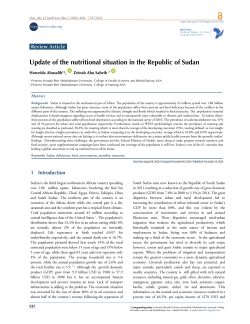Main Article Content
Update of the nutritional situation in the Republic of the Sudan
Abstract
Background:Sudan is situated in the northeastern part of Africa. The population of the country is approximately 43 million, spread over 1.88 million square kilometers. Although Sudan has great resources, most of the population suffers from poverty and food deficiency because of the conflicts in the different parts of the country .The suffering was augmented by climatic drought and floods which resulted in food insecurity. The population’s internal displacement is disadvantageous regarding access to health services and is consequently more vulnerable to diseases and malnutrition. In Sudan, thirty-three percent of the population suffered from food deprivation according to the national survey of 2010. The prevalence of undernourishment was 31% and 34 % percent for urban and rural populations respectively. Furthermore, based on WHO epidemiologic criteria, the prevalence of stunting and wasting are classified as profound, 38.2%, for stunting which is more than the average of the developing countries( 25%), wasting defined as low weight for height also has a higher prevalence in under-five in Sudan comparing it to the developing countries' average which is 16.8% and 8.9% respectively. Although recent national survey data are lacking, it is evident that micronutrient deficiencies are a major public health concern from the sporadic studies’ findings. Notwithstanding these challenges, the government and the Federal Ministry of Health, move along to make progress towards nutrition and food security, some supplementation campaigns have been conducted but coverage of the population is still low. Sudan is one of the 61 countries that leading a global movement to end up malnutrition in all its forms







